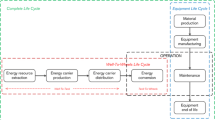Abstract
As the world witnesses a continual increase in the global energy demand, the task of meeting this demand is becoming more difficult due to the limitation in fuel resources as well as the greenhouse gases emitted which accelerate the climate change. As a result, introducing a policy that promotes renewable energy (RE) generation and integration is inevitable for sustainable development. In this endeavor, electrification of the transport sector rises as key point in reducing the accelerating environment degradation, by the deployment of new type of vehicles referred to as PHEV (plug-in hybrid electric vehicle). Besides being able to use two kinds of drives (the conventional internal combustion engine and the electric one) to increase the total efficiency, they come with a grid connection and interaction capability known as the vehicle-to-grid (V2G) that can play a supporting role for the whole power system by providing many ancillary services such as energy storage mean and power quality enhancer. Unfortunately, all these advantages do not come alone. The uncontrolled large scale EV integration may present a real challenge and source of possible failure and instability for the grid. In this work the large scale integration impact of EVs will be investigated in details. The results of power flow analysis and the dynamic response of the grid parameters variation are presented, taking the IEEE 14 bus system as a test grid system.
Similar content being viewed by others
References
International Energy Agency. CO2 emissions from fuel combustion highlights 2016 edition. 2016–01, http://www.iea.org/publications/freepublications/publication/CO2EmissionsfromFuelCombustion_-Highlights_2016.pdf
Beiter P, Tian T. 2015 renewable energy data book. 2015, www.nrel. gov/docs/fy17osti/66591.pdf
United Nations Framework Convention on Climate Change (UNFCCC). Paris declaration on electro-mobility and climate change &call to action. 2016–01, http://newsroom.unfccc.int/lpaa/transport/the-paris-declaration-on-electro-mobility-and-climatechange-and-call-to-action/
International Energy Agency. Global EV outlook 2016 beyond one million electric cars. 2016–01, https://www.iea.org/publications/freepublications/.../Global_EV_Outlook_2016.pdf
Guille C, Gross G. A conceptual frame work for the vehicle-to-grid (V2G) implementation. Energy Policy, 2009, 37(11): 4379–4390
Khoucha F, Benbouzid M E H, Amirat Y, Kheloui A. Integrated energy management of a plug-in electric vehicle in residential distribution systems with renewable. In: 2015 IEEE 24th International Symposium on Industrial Electronics, Buzios, Brazil, 2015: 717–722
Tan J, Wang L. Integration of plug-in hybrid electric vehicles into residential distribution grid based on two-layer intelligent optimization. IEEE Transactions on Smart Grid, 2014, 5(4):1774–1784
Karfopoulos E L, Panourgias K A, Hatziargyriou N D. Distributed coordination of electric vehicles providing V2G regulation services. IEEE Transactions on Power Systems, 2016, 31(4): 2834–2846
Lam A Y S, Leung K C, Li V O K. Capacity estimation for vehicleto-grid frequency regulation services with smart charging mechanism. IEEE Transactions on Smart Grid, 2016, 7(1): 156–166
Lin J, Leung K C, Li V O K. Optimal scheduling with vehicle-togrid regulation service. IEEE Internet of Things Journal, 2017, 1(6): 556–569
Wang Z, Wang S. Grid power peak shaving and valley filling using vehicle-to-grid systems. IEEE Transactions on Power Delivery, 2013, 28(3): 1822–1829
Sortomme E, El-Sharkawi M A. Optimal scheduling of vehicle-togrid energy and ancillary services. IEEE Transactions on Smart Grid, 2012, 3(1): 351–359
Han S, Han S, Sezaki K. Development of an optimal vehicle-to-grid aggregator for frequency regulation. IEEE Transactions on Smart Grid, 2010, 1(1): 65–72
Liu H, Hu Z, Song Y, Wang J, Xie X. Vehicle-to-grid control for supplementary frequency regulation considering charging demands. IEEE Transactions on Power Systems, 2015, 30(6): 3110–3119
Axsen J, Kurani K S, Mccarthy R, Yang C. Plug-in hybrid vehicle GHG impacts in California: integrating consumer-informed recharge profiles with an electricity-dispatch model. Energy Policy, 2011, 39(3): 1617–1629
Turker H, Bacha S, Chatroux D. Impact of plug-in hybrid electric vehicles (PHEVs) on the French electric grid. In: 2010 IEEE PES Innovative Smart Grid Technologies Conference Europe (ISGT Europe), Gothenburg, Sweden, 2010
Yilmaz M, Krein P T. Review of the impact of vehicle-to-grid technologies on distribution systems and utility interfaces. IEEE Transactions on Power Electronics, 2013, 28(12): 5673–5689
Dost P, Einwachter F, Spichartz P, Sourkounis C. Influence of electric vehicle charging demands on the grid load based on fleet measurements. In: 2014 IEEE Vehicle Power and Propulsion Conference (VPPC), Coimbra, Portugal, 2014
Saadat H. Power System Analysis. New Delhi: MacGraw-Hill Companies, 1999
Milano F. Power System Modelling and Scripting. Dordrecht: Springer, 2010
Power Systems Test Case Archive Web Site. 14 bus power flow test case. 2017–02–15, http://www.ee.washington.edu/research/pstca/pf14/pg_tca14bus.htm
Gao S, Chau K T, Chan C C, Wu D Y. Loss analysis of vehicle-togrid operation. In: 2010 IEEE Vehicle Power and Propulsion Conference, Lille, France, 2011
Gao S. Design analysis and control of vehicle-to-grid services. Dissertation for the Doctoral Degree. Hong Kong: The University of Hong Kong, 2014
Gao S, Chau K T, Liu C H, Wu D Y, Chan C C. Integrated energy management of plug-in electric vehicles in power grid with renewable. IEEE Transactions on Vehicular Technology, 2014, 63 (7): 3019–3027
Fetea R, Petroianu A. Reactive power: a strange concept? In: 2nd Europe Conference on Physics Teaching in Engineering Education, 2000
Author information
Authors and Affiliations
Corresponding authors
Rights and permissions
About this article
Cite this article
Boudina, R., Wang, J., Benbouzid, M. et al. Impact evaluation of large scale integration of electric vehicles on power grid. Front. Energy 14, 337–346 (2020). https://doi.org/10.1007/s11708-018-0550-6
Received:
Accepted:
Published:
Issue Date:
DOI: https://doi.org/10.1007/s11708-018-0550-6




